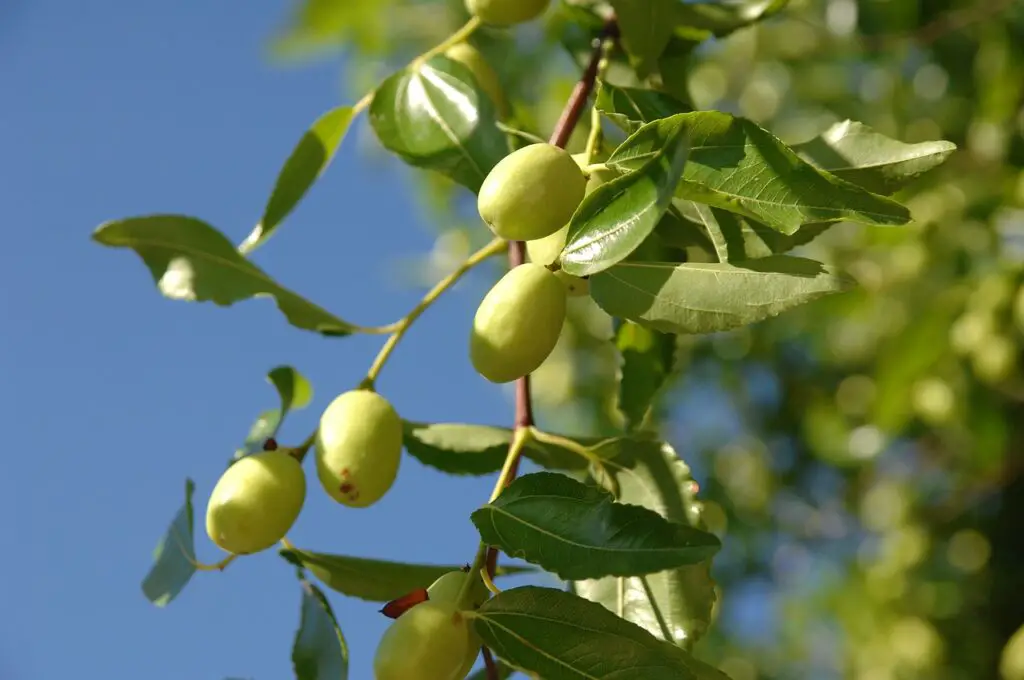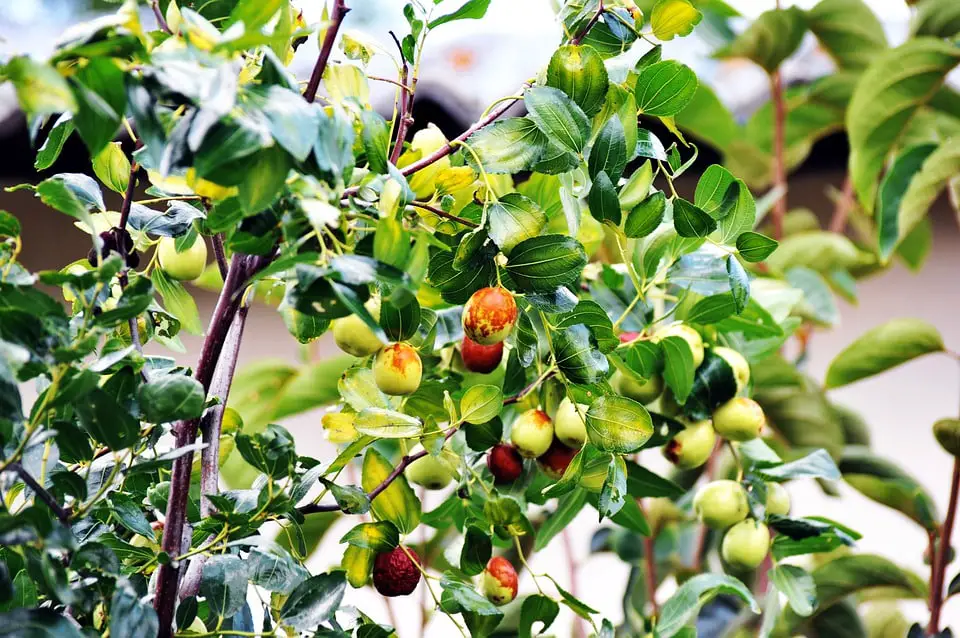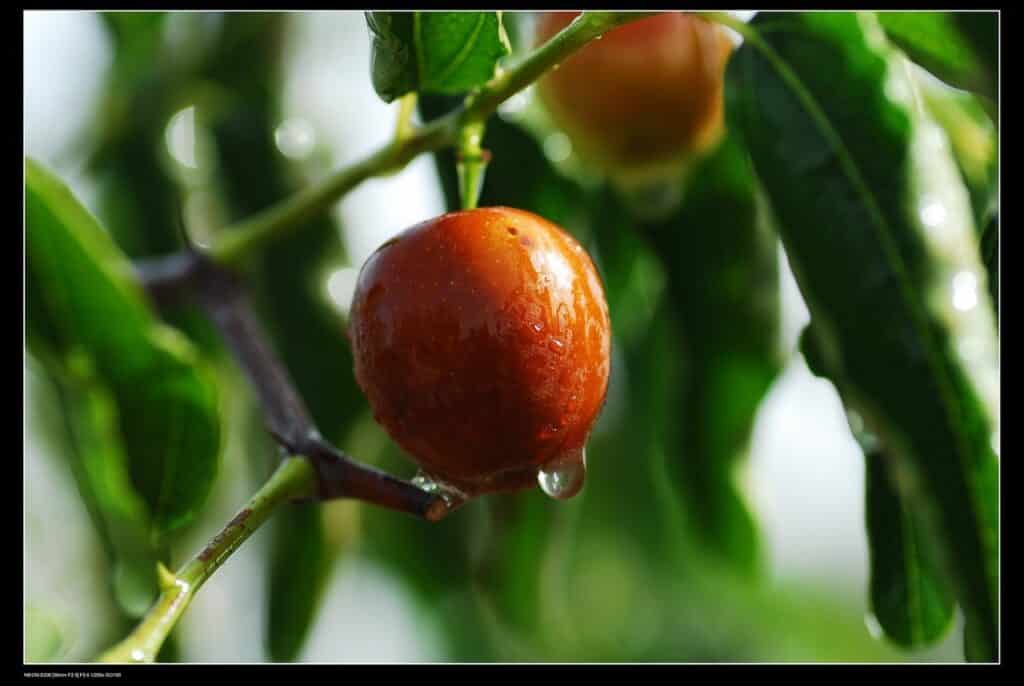Want a plant that gives you the fruit with little or no effort? Then you need to know how to grow the Jujube plant from seed. This Chinese native plant, also known as Chinese date, is very easy to take care of and is resilient. It provides comfort and fruit to the gardener after the process of planting is done properly.

Jujube Fruit
Are jujube and dates the same?
Jujube fruit has been used as a medicine for more than thirty centuries. Nowadays this fruit is popular all over the world. This plant is native to China. This is also known by some other names such as Chinese date and red date. Native to Chinese areas, it has been grown in the US areas for around one and a half centuries.
The fruit ranges in shape and size. It can be as small as a cherry or as big as a plum. It has edible skin-like dates and whitish flesh inside. When ripened it turns red and has wrinkles on it. Jujube is still edible when it turns hot red.
Moreover, this plant has green and white flowers which create a good sense of decoration. Also, this plant’s fruit has many health benefits. You can use it as medicine in many cases in consultation with a doctor or proper physician. The reason for this is that it is known as ancient medicine.
Why a Jujube Fruit Plant?

How big do jujube trees get?
Consider growing this plant in your home garden as it has many benefits. This plant can grow up to 30 to 50 feet high. Which makes it one of the shade-providing trees for gardeners. Also, the ornamental value of flowers and these flowers turn into red dates, which have many medical benefits and are delicious to eat.
Secondly, this plant is native to China, but it has been grown in other parts of the world for quite some time. Especially in the United States, it has grown for more than a century. Its hardiness zones are 7 to 10. It is widely grown in sub-tropical areas and even in temperate zones like the Northwest.
Also, this plant is easy to take care of. You just have to follow the set of information from the start of the germination process till the plantation. Then it can grow in any soil, without minding any pH in the given soil. It needs sunlight to effectively grow.
So, these available benefits and little or no care to grow this beautiful fruitful Jujube makes it a more desirable plant for gardeners. These Jujube plants are also drought-tolerant and prickly.
Adding further to its easiness, these Jujube plants are pest and disease-resistant. There is not much to take care of in this regard. So once planted successfully, you can enjoy it for a longer period of time.
How to Grow Jujube Plant from Seeds
Can you grow a jujube from seed?
Growing the jujube fruit is not so difficult. You have to follow some normal steps and you are good to go. Most people have found it very easy because of the results (in the shape of trees and fruit) it has produced. Follow these steps to grow this plant.
Getting the Jujube Plant Seeds
How do you germinate jujube seeds?
First of all, get the jujube fruit which is ripened enough and has a red color. Peel it and take the seeds out. Wash it and scrub the seeds in the running water to remove any of the flesh.
Cold Stratification of Seeds
Get the seeds in the sealable plastic bag and wrap them in the sphagnum moss. Leave the bag half-open to get the excess moisture out. Then store the seeds in the refrigerator for two or three months to stratify. Moisten the sphagnum moss when you feel it damp inside.
Soaking and Scarifying the Jujube Plant Seeds
Then soak the seeds in the bowl of water for around 24 hours. Jujube fruit doesn’t need any special treatment to break dormancy. Rub the sides of the jujube seeds and crack the endocarp with a nutcracker. It breaks the harder core outside and helps in the fast germination of seeds.
Soil Preparation and Sowing Jujube Fruit Seeds
Mix half of the soil and half of the organic compost material. Make sure the pot has enough drainage holes so that excess water is out and does not cause any problems inside the pot or a container. You should also check for any weeds in the mixture of the soil. Get the soil moistened by spraying or pouring the water.
Now fill the pot with the mixture that you have prepared. Sow the jujube seeds about half-inch to one-fourth inches deep. Keep a small layer of soil on the seeds. You can press the seeds down in the soil. After it has been sown, water the soil and keep the pot in a sunny place where it should get a temperature around 65 to 75 F.
Now everything is in place. You need to keep watering to keep up with the moisture until the seeds have germinated. Once the seeds have started sprouting, allow the sprouted seedlings to dry between the two periods of watering.
Transplanting the Jujube Seedlings to Beds
Now if the seedlings of jujube fruits have grown about 5 to 7 inches tall, you need to transplant them to the beds or the area where you want to plant the jujube.
Preparing the Soil and Planting Jujube Plants
Select the location wherever you want. This plant can survive very harsh cold weather up to -29 F. But it is good if the selected place has warm temperatures and sunny weather. Because this plant prefers such conditions.
Amend and till the soil by digging the soil up to 5 inches deep. Now sow the seedlings at the same level as they were in the pot. Make sure the soil is moistened before sowing and the holes have covered the root balls of the seedlings.
Water the plants enough until the soil puddles. Make sure to keep a reasonable distance among the plants while planting. As mentioned previously this plant can grow up to 40 to 50 feet long. So, the distance between the plants is necessary to keep up with the required space.
Taking Care of Jujube Fruit Plants
Care for the jujube is not very intensive. This plant is drought-tolerant, and it can survive in the harsh winters also. It can survive at low temperatures., but it prefers warm and sunny weather.
Watering Schedule for Jujube Fruit Plants
How often do you water jujube trees?
In the start when planted, watering is necessary. You have to keep up with the required amount of moisture. You can check the moisture in the uppermost layer of the soil with the help of your fingers.
Once established, you can reduce the frequency of watering the plants to once a month. It is drought tolerant, but proper watering in the early phase is required. It has been observed that those plants performed well, that were watered well in the early phase of growth.
Use of Fertilizers for Jujube Fruit Plants
As the seedlings were planted when they were the size of 5 cm. You should add fertilizers to ensure consistent growth. Once the plant has grown up to 60 to 65 cm long you can decrease the frequency of adding fertilizers.
Keep a keen eye on your plant. Pale and yellow leaves show a deficiency of nutrients. If you see such symptoms add fertilizers that have iron, manganese, or magnesium. You can also consult with nearby horticulturists.
Grafting the Jujube Fruit Plants
Most of the time jujube plants get to the fruiting without grafting. Sometimes it misses because of not being grafted. You can graft it to make sure it produces fruits. You can remove the branches from the side and perform the process of grafting on the main stem also as you want. Plants will be ready for grafting in about two years.
Pruning the Jujube Fruit Plant
Jujube fruits are fast-growing plants, as it is drought tolerant, when it is under the care of the gardener it grows faster. You can prune it to keep a nice shape and make it look good. You can prune the jujube plants when they are dormant, in the late fall or early winter.
Picking the Jujube Fruit

These fruits are ready to be picked and eaten when their color changes from light green to brown. To enjoy it, pick it up in the morning for the finest flavor. These fruits can be used in many ways. You can eat it raw, or you can use it in many recipes as it tastes like apples.
The majority of jujube fruits ripen in the month of October. If picked green, it will not get to the full ripening stage. If it is picked pale yellow, it will ripen to the full stage of red. When sealed in a plastic bag and exposed to ethylene gas it will get fully ripened. The ripened fruit is more delicious to eat.
In a nutshell, by planting the jujube you will not only add one fruitful tree to the garden, but you will be able to get many benefits in different aspects from this tree with little effort.
You May Also Like
HOW TO GROW WATERMELON RAISED BED
References
https://www.ehow.com/how_8246778_grow-jujube-seeds.html
https://www.houzz.com/discussions/1589429/please-help-tip-how-to-grow-jujube-from-seed

